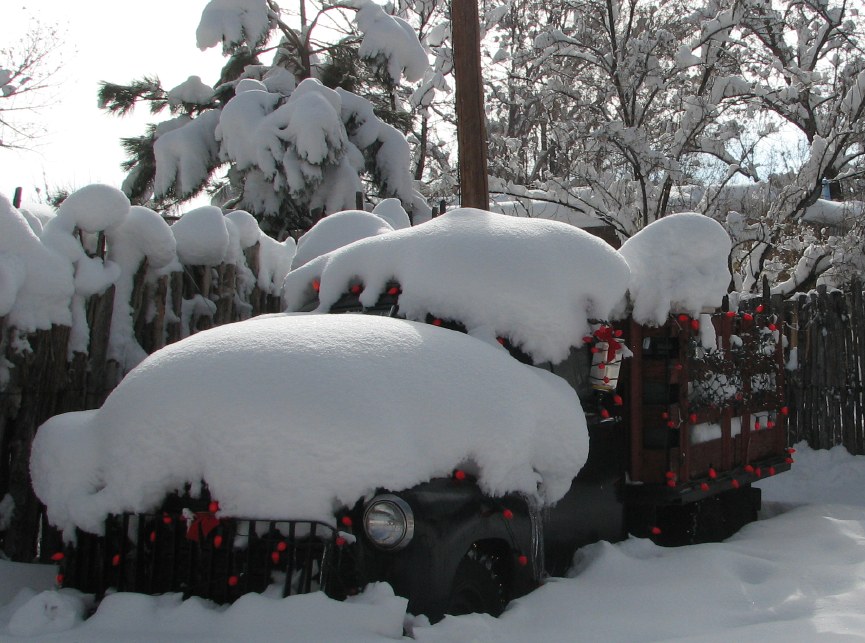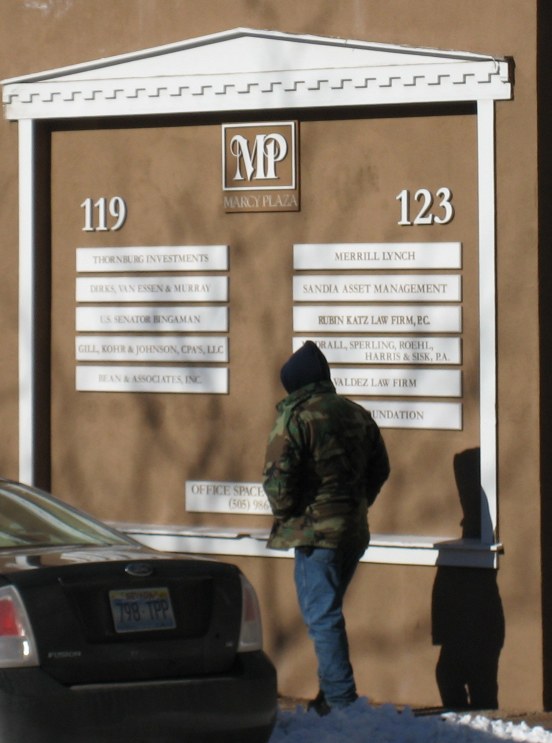

copyright 2007 by George Johnson

Christmas truck, Camino don Miguel. photo by George Johnson, copyright 2007
1. Retrofit Arithmetic (and Rainbarrel Economics)
2. The San Juan-Chama Shell Game
3. The Case of the Disappearing Aquifer
4. The Creative Hydrology of Suerte del Sur
5. The City, the County, and a Water Tax Revolt
6. Water Numerology at City Hall
(Our story thus far)
7. The Woman at Otowi Gauge
8. "Forget it, Jake. It's Chinatown."
9. The Las Campanas Connection . . . desalination word games . . . and Aamodt South
(Our story continues)
10. The Engineering Solution
11. The Sorrows of San Acacio
12. The City's Dubious Water Report
13. Where the Water Went
14. Shutting Down the River Again
15. Picking on the Davises
16. The Tom Ford Webcam
17. Galen Buller's Day Off
18. Forgive and Forget
19. Election Postmortem
20. El Molino Gigante
21. Hotel Santa Fe. . . Mansion Watch . . . Water Watch
(Our story continues)
22. The Environmental Impact of Jennifer Jenkins
23. The Short-term Rental Racket . . . Water Watch . . . Mansion Watch . . . Surreal Estate
24. Archbishop Lamy's Parking Lot
25. Mayor Coss's Lost Gamble
26. Tommy Macione Swamp
27. Sweeney Center Blues
28. The Tragedy of the Commoners
29. Councilors, Cops, and Russian Dolls
30. West Side Story
31. Taking Back the River
32. The Case of the Clovis Pigs
33. The San Juan-Chama Shell Game Revisited
34. The Santa Barbara Review
and The Return to Santa Fe
35. Kepler's Inquisition . . . The Ballad of Jerry Peters . . . Death Comes for the First Lady . . . Wi-fi Paranoia . . . Christmas Eve . . . and the Blizzard of '06
January 1, 2007
36. The Top 10 Stories of 2007
With the local papers offering their annual lists of last year's top news stories, I'm jumping ahead with my predictions -- more like dreams -- for the 10 biggest stories of the coming year.

January 3, 2007
End of the Year Report
Other than this flummoxing snowfall, my biggest surprise since returning from Santa Barbara (where it is currently sunny and 64 degrees) is how little progress has been made on the Tom Ford mansion. Except for a cedar post gate at the top of Camino Santander, blocking access to neighbors who used to walk up to admire the view, the only sign of construction is an unsightly chainlink fence surrounding the perimeter and drooping across the northwestern face of the hill.
Traffic to the Tom Ford webcam has nevertheless remained steady. Total earnings for 2006 from the Google ads automatically inserted there: $6.52 of which $6.46 has been ploughed back into ads, also via Google, for The Santa Fe Review. (This is not actually as good as it sounds. While Google collects what I owe it with a monthly debit to my bank account, it won't pay me my camera revenue until it has reached $100, which should happen sometime toward the end of the next decade. It's a little like trying to make money at a casino -- one more reason why I expect Google to take over the world.)
I know I am lucky that my commute consists of a walk upstairs to my office, but I still find some of the complaints about snow removal -- like those reported in today's New Mexican -- pretty unreasonable. This was our largest snowfall in recorded history. Of course it is going to take a few days to clean up. Especially churlish was the editorial in the New Mexican:
This place has been so blessed -- or is that cursed? -- with so many dry winters that our politicians have felt free to spend the city treasury on frivolities, with precious little thought to a snow emergency.
What frivolities were those?
I did, however, appreciate Julia Goldberg's take on all this:
For all the talk about emergency preparedness, we are clearly not prepared for a snowstorm, let alone a terrorist attack. In fact, terrorists could attack us with snow and we'd be pretty much screwed.
Meanwhile, I've noticed that despite the warning in the paper that trash pickup is a day behind, San Acacio's was retrieved this morning right on schedule. Great service, I'd say. And the mail carrier, who couldn't have been more cheerful, said he will probably be working until midnight.

January 4, 2007
The Lovebug Infestation
One of the nicest things about winter in Santa Fe is that the lovebugs go into hibernation. For a joyous few months, residents are spared the blaring public address system used by the blue tourist trams with the faded yellow tops run by a company called Custom Tours By Clarice. From spring until fall, the neighborhood resounds with the amplified voices of the drivers, calling out the sights like barkers at a midway freak show. Worst of all is when the company's owner, Clarice Coffey, is at the wheel.

Last year Ms. Coffey was cited by the state for 21 violations, including not having a commercial driver's license. Now she is back in the news again. At her behest, Councilor Ortiz is asking that the city temporarily lower the licensing fee it charges her and her competitors to park and pick up customers at downtown locations. With construction of the new convention center and state history museum cutting into business, that may not be an unreasonable request (though why not compensate all the downtown merchants?) Maybe in return, the city can require her to clean up her act.
The trams run by Fiesta City Tours, owned by former city councilor Frank Montaño, are practically silent, and the drivers for Loretto Line are only a little too loud. But the lovebugs are so obnoxious that last summer I came close to buying my own megaphone ($99.99 at Radio Shack) so I can yell right back.

January 7, 2007
Railroaded
Ever since the controversy over REI's plan to move into the publicly financed Railyard center, I've been trying to remember the name of a funky outdoor supply store that used to be on San Francisco Street, just half a block off the Plaza. I'd go there, on the way to Collected Works, to buy topo maps or hiking socks from cheerful young sales clerks who probably spent their free time snowshoeing to Lake Katherine or scaling the Truchas Peaks with ice axes.
Then one day the store was replaced by a Banana Republic, and after a brief stint on Montezuma Street it disappeared altogether. When I didn't get the same good vibes from the other local outfitters, I started patronizing the REI in Albuquerque. It may be misleading to represent itself as a "consumer co-op" (judging from an article in The Seattle Weekly), but I'm still impressed every time I walk through the door by the quality of the merchandise and the enthusiasm of the staff. A business need not be locally owned to be good.
It was not Carrows or Wendy's that led the fight against Santa Fe's higher minimum wage but Zia Diner, Pranzo, San Francisco Street Bar & Grill, and Maria's. It is not Donald Trump but local entrepreneur Gerald Peters who has turned much of the south side of San Francisco Street into a pueblo-style shopping mall. Is the locally owned Five and Dime really preferable to the old Woolworth's, or the Riva-Yares Gallery to the Safeway chainstore it replaced on Grant Street?
As Karen Peterson points out in an editorial in today's Journal, most of the Railyard tenants, by far, will still be locals. But their wares will be all but indistinguishable from what's available on the Plaza. The emphasis, she writes, should be "on locally needed, as opposed to locally owned." The Railyard, after all, was supposed to become "a new urban center for Santa Fe."
Instead we are getting Asian Adobe, Captain Marble, TAI Gallery, Victoria Price Contemporary Arts, Gebert Contemporary Art, William Siegal Galleries, Alan Burrus Architectural Interiors . . . Other than the Farmer's Market and the movie complex (operated out of Los Angeles), REI is just about the only reason why middle-class Santa Feans will want to shop there.
What has yet to emerge are numbers demonstrating that rents really had to be set so high that only these high-end retailers could afford them. If the Railyard fails to live up to the dream outlined in the master plan, it's not the out-of-towners who will shoulder the blame.

January 10, 2007
The Journal weighs in today on the attempt (mentioned here on January 4) by the lovebug trams to get a break on licensing fees:
In the annals of chutzpah, this request rates right up there. The construction in question is tourist-related: It includes the new city convention center and a new state museum. When these projects are finished (about two years from now) they will no doubt be a tourist draw -- no doubt to the benefit of the tour operator. In the meantime, why isn't she willing to share the downside -- some minor traffic inconvenience -- with the rest of us?
Meanwhile I am hearing from readers intrigued by the idea of buying bullhorns to greet the lovebugs when they begin their noisy rounds this spring.
January 14, 2007
37. The Thornburg Dilemma

Looking back, the first hint that Garrett Thornburg might have trouble building his grand corporate campus in northwest Santa Fe came last April in a New Mexican report on his company's annual shareholder meeting at the Inn of Loretto. Though enthusiastically headlined THORNBURG STILL GOING STRONG, the article went on to note that its mortgage-lending operation was being threatened by rising interest rates and the sinking housing market.
Three months later came a story, CONSTRUCTION COSTS 'GONE CRAZY,' in which a Thornburg executive lamented that the projected price of the 100,000-square-foot complex had increased by as much as 20 percent. Throughout the fall building costs continued to grow higher while the mortgage business declined. Though Thornburg Mortgage Inc. remained more buoyant than many of its competitors, one financial analyst after another has been downgrading its stock.
Even so it came as a shock to read in yesterday's New Mexican that the company is asking the city for help in the form of industrial revenue bonds. Thornburg argues that it is owed this public largesse because of the delay, caused by a neighborhood group's lawsuits, in approving his building plans.
Though you'd hardly know it from the coverage so far, this promises to be one of the most controversial political stories of the year. As explained by attorney Alan Hall of the Rodey law firm in Albuquerque, industrial revenue bonds are basically a way of circumventing the state constitution's "anti-donation clause," which prevents governments from putting taxpayers' money into private hands.
In these financial shell games, a company deeds its land to a city or county, which then leases it back to the company, with the proceeds from the rent going to the purchaser of the bonds. Since the project becomes, on paper, a public enterprise, it is tax-exempt. No property taxes, no sales taxes on computers, desks, or other depreciable goods. In return, the beneficiary supposedly invigorates the economy by bringing new jobs. Thornburg, of course, is already here.
In this case the bonds themselves would be what Mr. Hall calls "legal fictions." Since the purchaser would be another arm of Thornburg, the enterprise would be borrowing the money from itself. What it wants is the tax relief.
Before approving this kind of government aid, municipalities often demand some kind of "payment in lieu of taxes" to make up for the added drain on services that the rest of the community is being asked to bear. In a savvy peremptory move, Thornburg, as "a gesture of good will," proposes to reimburse the city's portion of the lost property taxes. It's counties and school boards, of course, that are most dependent on property tax income. But they're not the ones who would have to sign off on the deal.
Whether this will fly with City Hall is hard to predict. In the tumultuous 2004 election Thornburg and his allies worked hard to unseat councilors perceived to oppose the company's plans -- all three remain in office -- and two years later they backed losing mayoral candidate David Schutz. Next week when the company reports its fourth-quarter earnings, the news may be of as keen an interest on Lincoln and Marcy as it is on Wall Street.
The Sunday Papers
In a fascinating story in today's Journal, Russell Max Simon reveals that in calculating the maximum allowable heights for downtown buildings, the city has been using the wrong information. The complex tale, involving aerial surveys, a corrupt database, the discovery of a missing map, and real estate attorney Karl Sommer's campaign to win approval for a third story on First National Bank's Palace Avenue project, reads almost like a good detective yarn. The bottom line is that some developers have probably been allowed to build too high while others have been unduly restricted. Mr. Simon has been covering development issues with an acumen that has made the Journal indispensable for understanding what is going on in Santa Fe.
January 18, 2007
Thornburg: the Story Continues
Knowing what we know now about the Thornburg enterprise's plans to seek a government subsidy for its new headquarters, an event last October called Santa Fe Design Week takes on a different sheen. Aimed at promoting the city as a leader in creative, eco-friendly development, the workshops, lectures, and discussion panels were sponsored by an odd assortment of government agencies (the Santa Fe Water Department, the New Mexico Department of Economic Development . . .) and local businesses, the most generous of which was the Thornburg Companies.
Near the end of the week, Mr. Thornburg himself gave a presentation, clunkily titled "Thornburg Campus Design: Environmentally Advanced Design for Santa Fe's Business Future," which was accompanied by the distribution of a color brochure with testimonials from Councilor Rebecca Wurzburger ("the kind of economic development project we need") and Mayor David Coss ("a great addition to the Tano Road community, as well as the city of Santa Fe"). The mayor apparently holds no grudge for the thousands of dollars Mr. Thornburg and other company officials gave to his opponent, David Schutz, in the recent election.
Some of the sessions sounded a little New Agey ("Planetary Citizenship: Shaping a Sustainable World," "Transcendental Homes and Gardens -- Applying Vastu, the Yoga of Design"), and the event was not an economic success. According to the Journal the take from the exhibitors' booths, $15,000, was half of what had been expected. Because of other contingencies the city has been hit with $38,000 in cost overruns. Still it looks to have been an inspiring gathering of innovative thinkers, and for Mr. Thornburg to have planted his project square at its center was another of his public relations coups.
From there the lobbying intensified, with the company appearing as one of 16 "gold sponsors" ($10,000 to $25,000) at Governor Richardson's inaugural ball. (The governor is also quoted in the Thornburg brochure.) More recently city councilors have been called one by one to the Thornburg offices near City Hall so they can be sold on the wisdom of having their constituents foot part of the company's construction bills.
It will be instructive to see how the vote goes. Thornburg executives (along with Mr. Thornburg's wife, Catherine Oppenheimer) donated to Ms. Wurzburger's recent campaign and to that of Councilor Carmichael Dominguez. But they also supported the unsuccessful bids of Carol Robertson Lopez (who now works for her biggest donor, developer Donald Tishman) and Eric Lujan. Maybe their winning opponents, Chris Calvert and Ronald Trujillo, will be as understanding as Mr. Coss has been.

January 21, 2007
The Sunday Papers
It's remarkable and even a little eerie that, except for the corporate puff piece that ran in the business section of last Saturday's New Mexican, there has been nothing in the papers about the Thornburg matter, including any editorial commentary. The New Mexican didn't even mention the news in its "Week in Review" reprise. The Journal so far has missed the story entirely, probably because Russell Simon has been in Hobbs covering cockfighting. (The result is an excellent piece of journalism, with a gritty objectivism -- "That rooster's dead, he just don't know it yet" -- that is far more effective than any preachy moralism.)
There are other good things in this morning's papers: An insightful editorial by Karen Peterson on downtown building heights, and a perfectly timed analysis by Anne Constable on the "new and sleeker" Candidate Richardson. But the Thornburg story, coming out of the blue, seems to have everybody flummoxed.
on to Part 38, Santa Fe's Dying River Plan . . .
Coming Soon: The Battle for Talaya Hill
The Andrew and Sydney Davis Webcam
Santa Fe Review Detours of the Wild West
The Santa Fe Review

More links:
See the current flow of the Santa Fe River above McClure Reservoir with the USGS automated gauge.
The Otowi gauge shows the flow of the Rio Grande north of Santa Fe.
Santa Fe water information, a collection of documents and links